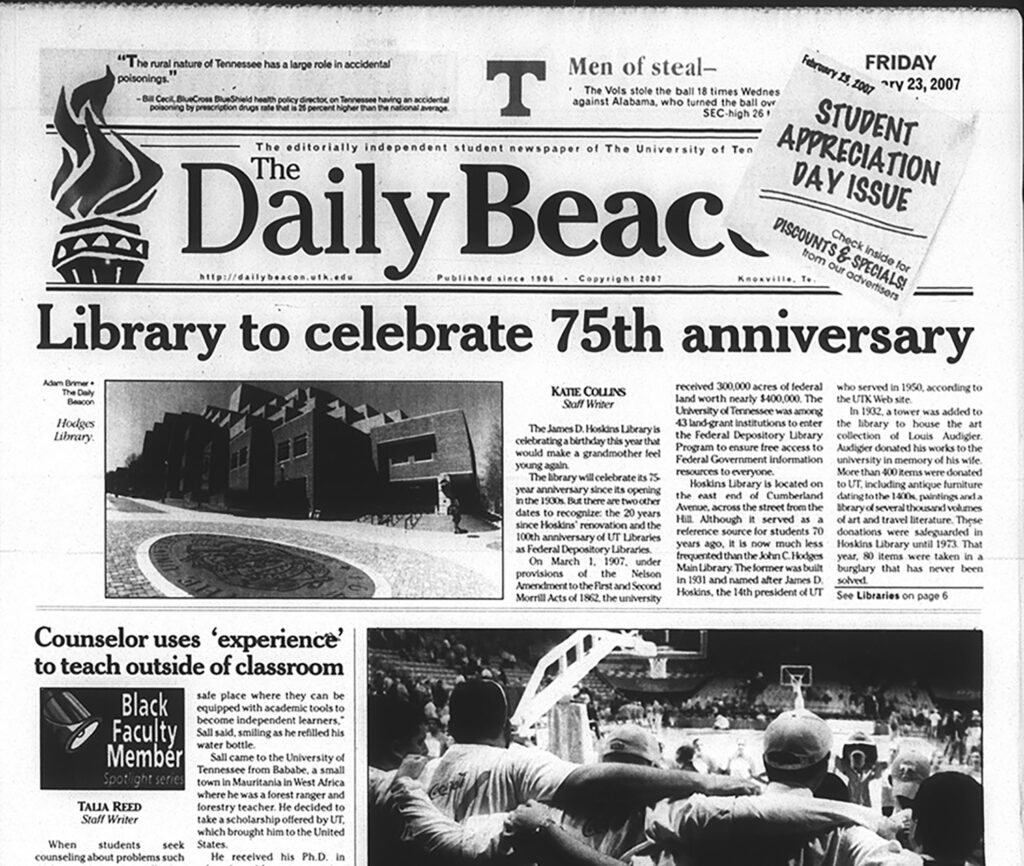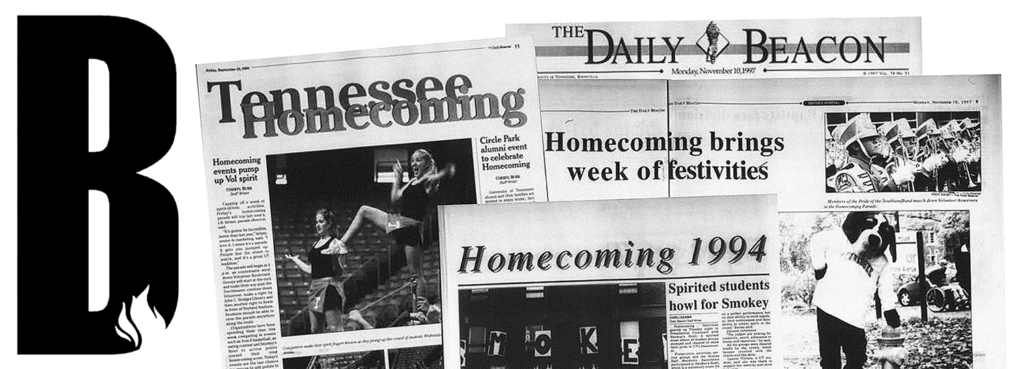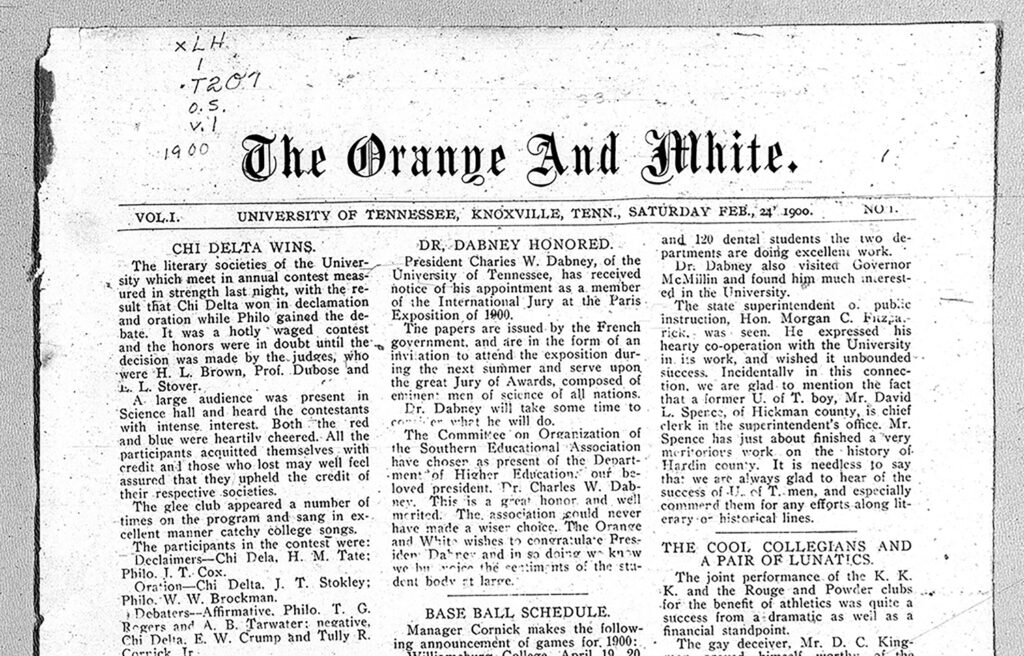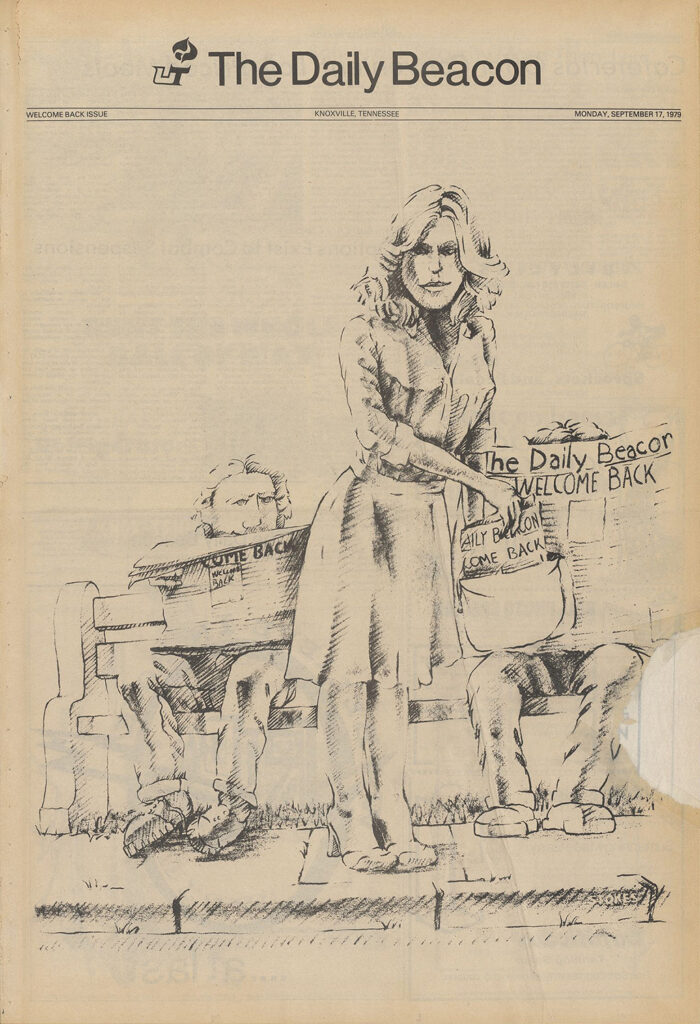The University of Tennessee’s student newspaper, The Daily Beacon, serves as a time capsule of cherished memories, capturing the laughter, triumphs, and stories of countless students throughout the history of the university.
Alumni recall experiences from their college days, reminiscing about the time spent during what many consider the most fun years of their lives. Before smartphones and digital devices, few tools existed to capture the everyday moments of campus life. However, one constant throughout the university’s history has preserved the highlights of student experience: The Daily Beacon.
Thanks to a recent digitization project launched by UT Libraries and Creekside Digital, The Daily Beacon’s rich history is now more accessible than ever. After years of careful preservation of student publications, the project is complete, making decades of archived issues from 1900 through 2016 available through the Libraries’ Digital Collections (tiny.utk.edu/DailyBeaconCollections). Whether you wish to explore the newspaper’s very first issue in the early 20th century or revisit coverage of the university’s response to major events, the collection is available to all.
The campus newspaper dates all the way back to 1900, where its first iteration was titled The Orange and White. The paper began publishing weekly in 1906 and later transitioned to a semi-weekly format to accommodate the growing demand for campus news.
During The Orange and White’s tenure, a wave of significant events beyond campus — including World Wars I and II, the women’s suffrage movement, and the Great Depression — deeply affected student life, shaping the content and tone of the paper as it chronicled those transformative times. The paper grew beyond a simple campus newsletter to become a lens through which global events resonated at UT. Contributors to The Orange and White shared stories of the war efforts, economic hardships, and societal changes that shaped their generations. While the weekly campus newspaper served its purpose for decades, there was an eventual need for a daily newspaper that would meet the demands of a growing student body.
The Daily Beacon launched on April 20, 1965, marking the evolution from The Orange and White to a modern daily student newspaper. Lynda Leftwich Newton became the first editor-in-chief, and she made it her goal for the paper to be a representative voice for the university community. The Daily Beacon would soon gain more popularity for its crossword puzzles, crime logs, and investigative stories about campus life and administration. Students knew exactly where they needed to go to keep abreast of campus news.
Like The Orange and White, The Daily Beacon has been shaped by major events and movements beyond the university, each leaving a lasting impression on students. From the Civil Rights movement, which sparked discussions surrounding race and equality within the campus community, to students taking to the streets in Vietnam War protests, pivotal moments resonated throughout university life as students navigated the effects of events.
The women’s rights movement and passage of Title IX in 1972 proved to have a profound effect on the university, allowing women equal opportunities in academics and athletics. Two years after Title IX was passed, the women’s basketball program had the good fortune to hire head coach Pat Summitt, who would go on to coach for 38 seasons. During her tenure as head coach, she would lead the Lady Vols to eight national championship titles and 32 SEC titles, cementing their legacy as one of the most successful women’s athletic programs of all time.
The Watergate scandal of 1972 had a significant impact on The Daily Beacon as it changed the landscape of journalism from that point forward. After the scandal, the country saw an increase in investigative journalism, an altered perception of the media by the public, more discussions about journalistic ethics and standards, and more politics involved in the world of journalism. Those developments inevitably had an effect on The Daily Beacon, changing how stories were written and how news was reported.
Decades later, another factor changed how The Daily Beacon was written and consumed: the internet. The development and spread of internet technology in the 1990s transformed campus life, and many Daily Beacon contributors reported on the integration of computers, the World Wide Web, and how this major shift affected education, research, and student communication. The Daily Beacon, which had produced physical copies of the paper throughout its existence, moved most of its content online due to the preferences of its readers.

The terrorist attacks of September 11, 2001, had a profound effect on the nation. Students on campus saw a rise in national security concerns, different attitudes toward global politics, and student involvement in relief efforts—all of which were reflected in The Daily Beacon.
In recent years The Daily Beacon has increased its social media presence as readers react to major events and movements, including the Black Lives Matter and LGBTQ+ rights movements that have shaped the student experience over the past decade. Contributors to The Daily Beacon have found ways to capture protests organized by students as well as student advocacy for policy changes. While the editors still publish campus newsletters and papers in traditional formats, a growing presence on social platforms such as Instagram, Facebook, and X (formerly Twitter) expedites awareness of national issues affecting campus life.
The Daily Beacon increased its presence on social media and other online platforms as contributors navigated ways to produce content during the COVID-19 pandemic. The whole world as everyone knew it was essentially shut down, but there were still stories that needed to be told. For over a year, The Daily Beacon covered a variety of topics surrounding the pandemic’s effects on the university, including mask mandates, protests, health and safety guidelines, and vaccination updates. Through it all, The Daily Beacon remained a vital source of information, adapting to new challenges and ensuring that the UT community stayed connected and informed.
Whether readers are revisiting major historical events or curious about the everyday lives of past students, The Daily Beacon’s digital archive now stands as a bridge to generations of stories once believed to be lost—preserving them for future students, researchers, and alumni to discover for years to come.
The digital collection presently includes issues from 1900 to 2016, and plans are underway to add more recent issues to the archive.



